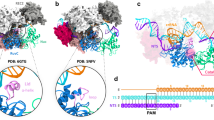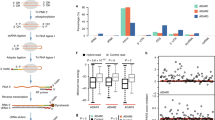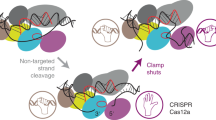Abstract
Long perfect double-stranded RNA (dsRNA) molecules play a role in various cellular pathways. dsRNA may undergo extensive covalent modification (hyper-editing) by adenosine deaminases that act on RNA (ADARs), resulting in conversion of up to 50% of adenosine residues to inosine (I). Alternatively, dsRNA may trigger RNA interference (RNAi), resulting in silencing of the cognate mRNA. These two pathways have previously been shown to be antagonistic. We show a novel interaction between components of the ADAR and RNAi pathways. Tudor staphylococcal nuclease (Tudor-SN) is a subunit of the RNA-induced silencing complex, which is central to the mechanism of RNAi. Here we show that Tudor-SN specifically interacts with and promotes cleavage of model hyper-edited dsRNA substrates containing multiple I·U and U·I pairs. This interaction suggests a novel unsuspected interplay between the two pathways that is more complex than mutual antagonism.
This is a preview of subscription content, access via your institution
Access options
Subscribe to this journal
Receive 12 print issues and online access
$189.00 per year
only $15.75 per issue
Buy this article
- Purchase on Springer Link
- Instant access to full article PDF
Prices may be subject to local taxes which are calculated during checkout








Similar content being viewed by others
References
Maquat, L.E. & Carmichael, G.G. Quality control of mRNA function. Cell 104, 173–176 (2001).
Samuel, C.E. Protein-nucleic acid interactions and cellular responses to interferon. Methods 15, 161–165 (1998).
Zhou, A., Hassel, B.A. & Silverman, R.H. Expression cloning of 2–5A-dependent RNase: a uniquely regulated mediator of interferon action. Cell 72, 753–765 (1993).
Silverman, R.H. 2–5A dependent RNase L: a regulated endoribonuclease in the interferon system. In Ribonucleases: Structure and Functions (eds. D'Alessio, G. & Riordan, J.F.) 515–551 (Academic Press, New York, 1997).
Bass, B.L. RNA editing by adenosine deaminases that act on RNA. Annu. Rev. Biochem. 71, 817–846 (2002).
Zamore, P.D. Ancient pathways programmed by small RNAs. Science 296, 1265–1269 (2002).
Denli, A.M. & Hannon, G.J. RNAi: an ever growing puzzle. Trends Biochem. Sci. 28, 196–201 (2003).
Novina, C.D. & Sharp, P.A. The RNAi revolution. Nature 430, 161–164 (2004).
Nishikura, K. et al. Substrate specificity of the dsRNA unwinding/modifying activity. EMBO J. 10, 3523–3532 (1991).
Polson, A.G. & Bass, B.L. Preferential selection of adenosines for modification by double-stranded RNA adenosine deaminase. EMBO J. 13, 5701–5711 (1994).
Serra, M.J., Smolter, P.E. & Westhof, E. Pronounced instability of tandem IU base pairs in RNA. Nucleic Acids Res. 32, 1824–1828 (2004).
Zhang, Z. & Carmichael, G.G. The fate of dsRNA in the nucleus: a p54nrb-containing complex mediates the nuclear retention of promiscuously A-to-I edited RNAs. Cell 106, 465–475 (2001).
Scadden, A.D.J. & Smith, C.W.J. Specific cleavage of hyper-edited dsRNAs. EMBO J. 20, 4243–4252 (2001).
Bernstein, E., Caudy, A.A., Hammond, S.M. & Hannon, G.J. Role for a bidentate ribonuclease in the initiation step of RNA interference. Nature 409, 363–366 (2001).
Hammond, S.M., Boettcher, S., Caudy, A.A., Kobayashi, R. & Hannon, G.J. Argonaute2: a link between genetic and biochemical analyses of RNAi. Science 293, 1146–1150 (2001).
Caudy, A.A., Myers, M., Hannon, G.J. & Hammond, S.M. Fragile X-related protein and VIG associate with the RNA interference machinery. Genes Dev. 16, 2491–2496 (2002).
Caudy, A.A. et al. A micrococcal nuclease homologue in RNAi effector complexes. Nature 425, 411–414 (2003).
Meister, G. et al. Human argonaute2 mediates RNA cleavage targeted by miRNAs and siRNAs. Mol. Cell 15, 185–197 (2004).
Liu, J. et al. Argonaute2 is the catalytic engine of mammalian RNAi. Science 305, 1437–1441 (2004).
Rand, T.A., Ginalski, K., Grishin, N.V. & Wang, X. Biochemical identification of Argonaute 2 as the sole protein required for RNA-induced silencing complex activity. Proc. Natl. Acad. Sci. 101, 14385–14389 (2004).
Scadden, A.D.J. & Smith, C.W.J. RNAi is antagonized by A to I hyper-editing. EMBO Rep. 2, 1107–1111 (2001).
Knight, S.W. & Bass, B.L. The role of RNA editing by ADARs in RNAi. Mol. Cell 10, 809–817 (2002).
Tonkin, L.A. & Bass, B.L. Mutations in RNAi rescue aberrant chemotaxis of ADAR mutants. Science 302, 1725 (2003).
Bass, B.L. Double-stranded RNA as a template for gene silencing. Cell 101, 235–238 (2000).
Yang, W. et al. ADAR1 RNA deaminase limits siRNA efficacy in mammalian cells. J. Biol. Chem. 280, 3946–3953 (2005).
Pharm, J.W., Pellino, J.L., Lee, Y.S., Carthew, R.W. & Sontheimer, E.J. A Dicer-2-dependent 80S complex cleaves targeted mRNAs during RNAi in Drosophila. Cell 117, 83–94 (2004).
Wollerton, M.C. et al. Differential alternative splicing activity of isoforms of polypyrimidine tract binding proteins (PTB). RNA 7, 819–832 (2001).
Cuatrecasas, P., Fuchs, S. & Anfinsen, C.B. Catalytic properties and specificity of the extracellular nuclease of Staphylococcus aureus. J. Biol. Chem. 242, 1541–1547 (1967).
Ponting, C.P. Tudor domains in proteins that interact with RNA. Trends Biochem. Sci. 22, 51–52 (1997).
Callebaut, I. & Mornon, J.P. The human EBNA-2 coactivator p100: multidomain organization and relationship to the staphylococcal nuclease fold and to the Tudor protein involved in Drosophila melanogaster development. Biochem. J. 321, 125–132 (1997).
Yang, J. et al. Identification of p100 as a coactivator for STAT6 that bridges STAT6 with RNA polymerase II. EMBO J. 21, 4950–4958 (2002).
Luciano, D.J., Mirsky, H., Vendetti, N.J. & Mass, S. RNA editing of a miRNA precursor. RNA 10, 1174–1177 (2004).
Levanon, E.Y. et al. Systematic identification of abundant A-to-I editing sites in the human transcriptome. Nat. Biotechnol. 22, 1001–1005 (2004).
Sambrook, J. & Russell, D.W. Molecular Cloning: A Laboratory Manual 3rd edn. (Cold Spring Harbor Laboratory Press, Cold Spring Harbor, New York, 2001).
Minshall, N. & Standart, N. The active form of Xp54 RNA helicase in translational repression is an RNA-mediated oligomer. Nucleic Acids Res. 32, 1325–1334 (2004).
Körner, C.G. et al. The deadenylating nuclease (DAN) is involved in poly(A) tail removal during the meiotic maturation of X. laevis oocytes. EMBO J. 17, 5427–5437 (1998).
Acknowledgements
I would like to thank G. Hannon, S. Holmes, N. Minshall, R. Allison, L. Colegrove, A. Devaux and C. Gooding for gifts of reagents, and the Cambridge Centre for Proteomics (in particular K. Lilley) for protein analyses. I would like to thank C. Smith for helpful discussions and critically reading the manuscript, and also N. Proudfoot and M. O'Connell for comments on the manuscript. This work was supported by a Research Career Development Fellowship from the Wellcome Trust. The Cambridge Centre for Proteomics facility at Cambridge was funded by the UK Biotechnology and Biological Sciences Research Council's Investigating Gene Function Initiative.
Author information
Authors and Affiliations
Corresponding author
Ethics declarations
Competing interests
The author declares no competing financial interests.
Rights and permissions
About this article
Cite this article
Scadden, A. The RISC subunit Tudor-SN binds to hyper-edited double-stranded RNA and promotes its cleavage. Nat Struct Mol Biol 12, 489–496 (2005). https://doi.org/10.1038/nsmb936
Received:
Accepted:
Published:
Issue Date:
DOI: https://doi.org/10.1038/nsmb936
This article is cited by
-
The important role of miR-1-3p in cancers
Journal of Translational Medicine (2023)
-
Novel insights into double-stranded RNA-mediated immunopathology
Nature Reviews Immunology (2023)
-
Reduction of A-to-I RNA editing in the failing human heart regulates formation of circular RNAs
Basic Research in Cardiology (2022)
-
ADARs, RNA editing and more in hematological malignancies
Leukemia (2021)
-
Long-read sequencing uncovers a complex transcriptome topology in varicella zoster virus
BMC Genomics (2018)



